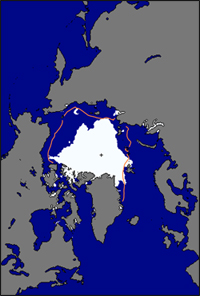 A new preliminary report from NASA confirms our worries. The sea ice at the Arctic is disappearing.
A new preliminary report from NASA confirms our worries. The sea ice at the Arctic is disappearing.
NASA reports that the Arctic sea ice has reached a second all-time low "since the dawn of the satellite era". Previous record low for September was in 2005. NASA says that this year' loss of sea ice "further reinforces the strong negative trend in summer sea ice extent observed during the past 30 years". In the past sea ice has covered about 60% of the Arctic. But this winter the sea ice covered less than 30%.
The image shows that the daily Arctic sea ice extent for September 12, 2008, was 4.52 million square kilometers (1.74 million square miles). The orange line shows the 1979 to 2000 average extent for that day. The black cross indicates the geographic North Pole. A high-resolution image can be found here.

Recommended Comments
Join the conversation
You can post now and register later. If you have an account, sign in now to post with your account.